On a warm July day, clouds of mosquitoes whine around my ears. Our boots squish across a wet patch of tundra as we head toward the Egaksrak River on the coastal plain of the Arctic National Wildlife Refuge.
Wading across a shallow channel, we see a shimmering mosaic of rounded stones. The water is gin-clear with nothing to pollute it. This wild river, and numerous others, flow north from the crest of the Brooks Range, through the foothills, meandering across the sweeping, pond-specked coastal plain until it reaches the Beaufort Sea – a distance of about 60 miles from mountaintop to sea in the northeastern corner of Alaska.
In the middle of this braided river, we stand on a gravel bar with spotty willow bushes. Looking out across the open plain, I see silhouettes in the distance, rising and falling. Thousands of caribou are migrating toward us, filling the horizon. As they grow closer, we hear the grunting, bleating and clicking of hooves.
Soon the tundra transforms into a jungle of legs and the ground appears to be moving. The Porcupine Caribou herd splashes across the river in front of us, young calves paddling hard to keep up with their mothers. We are surrounded by an explosion of life at its fullest moment.
While this vivid wildlife spectacle occurred nearly 40 years ago, it is etched in my mind as though it happened yesterday. Experiences in America’s largest and wildest refuge stay with you forever. And the long fight to protect this extraordinary place has gone on for decades – and it continues today.
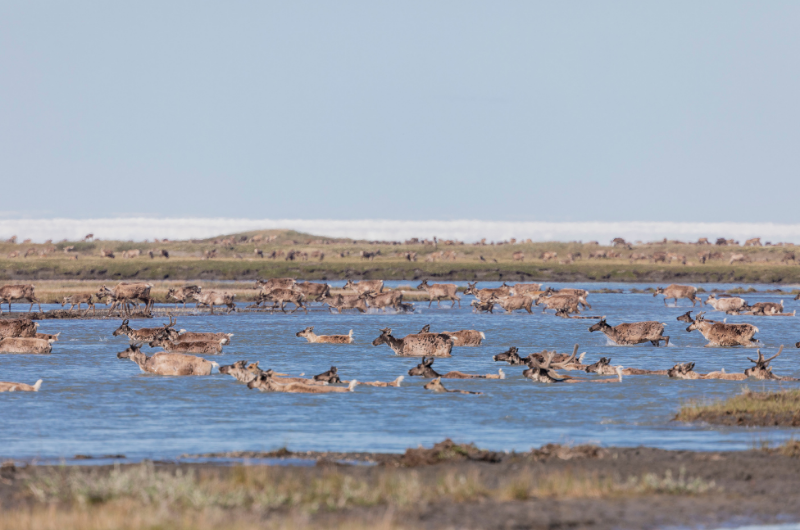 Every summer, thousands of caribou migrate across the Brooks Range to the coastal plain of the Arctic Refuge to bear their young.
Every summer, thousands of caribou migrate across the Brooks Range to the coastal plain of the Arctic Refuge to bear their young.
In the 1950s, the renowned wilderness advocates Olaus and Margaret Murie fell in love with this remote corner of Alaska while doing biological studies on the Sheenjek River. They, and other visionaries, educated the public about the wonders of the Arctic, the diversity of wildlife and why the region should be protected in its whole and natural state. Olaus, who served on the board of the League, was passionate about leaving this magnificent region unscathed, untrammeled, in its wilderness state.
Support grew on a regional and national level to protect a proposed “Arctic Range.” Leading conservation and sportsmen’s organizations behind this effort included the Izaak Walton League, National Wildlife Federation, the Wildlife Management Society and the Wilderness Society.
Joe Penfold, conservation director of the League, testified in 1959 at the first congressional hearing on proposed legislation to create an Arctic Range:
“We need only mention such wildlife species as the eastern elk, the Great Plains bison, the passenger pigeon, to illustrate resources which could have been preserved for today and for generations to come had we been foresighted….”
If we move forward wisely, future generations will have the opportunity to experience a true Arctic wilderness, with polar bears and caribou.
When the legislation stalled in Congress, the Eisenhower Administration took action. Before leaving office in 1960, President Eisenhower established the 8.9-million-acre Arctic Range by executive order for its “wildlife, wilderness and recreational values.”
Long before European explorers, scientists and conservationists discovered this great wilderness, it was, and still is, the homeland for two distinct cultural groups: the Gwich’in Athabaskans on the south side of the Brooks Range, and the Inupiat Eskimos on the northern Beaufort Sea coast.
Over thousands of years, these Indigenous people have depended on the resources of the Arctic for their food, culture, spiritual traditions and way of life.
For the Gwich’in Nation in Alaska and Canada, a dozen communities rely on the Porcupine Caribou herd for feeding their families, sewing clothing and boots from the hides and other cultural and traditional uses.
“We are caribou people,” said Sarah James, a tribal leader and elder from Arctic Village who has voiced her support for protecting the Arctic Refuge coastal plain for three decades. Her dedication has included drumming and singing for weeks at a time on Capitol Hill, carrying her message to Congress.
The coastal plain is the birthplace and nursery ground for the Porcupine herd, one of the largest on earth. The Gwich’in have an eloquent name for the plain: “lizhik Gwats’an Gwandaii Goodlit,” which means the “sacred place where life begins.”
In 1980, after several years of public hearings and debates, the Alaska National Interest Lands Conservation Act passed Congress and was signed into law by President Jimmy Carter. This monumental act set aside and protected more than 100 million acres of national parks, wildlife refuges and forests in Alaska – a staggering amount of public land, about the size of California. The Alaska Lands Act, as it is commonly called, was a tremendous gift for future generations and for the world.
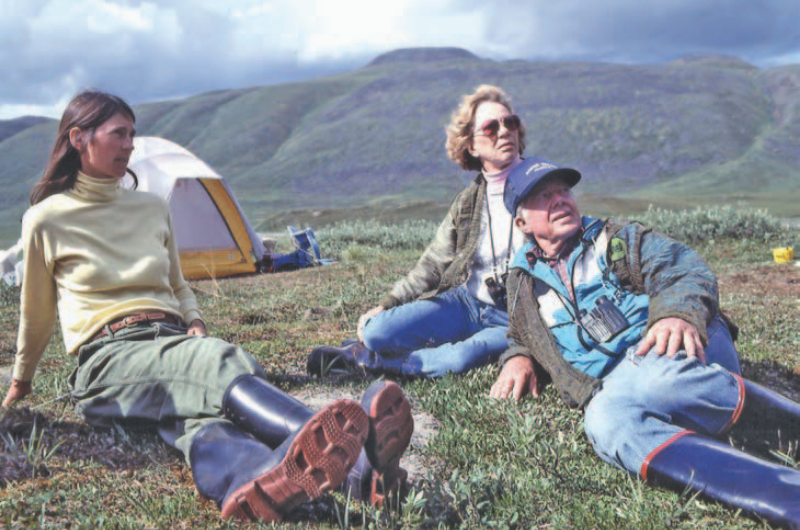 The author hosts President Jimmy Carter and wife Rosalynn at a camp in the Arctic Refuge in 1990 where they went fly fishing and saw the Porcupine Caribou herd. "We understand firsthand why some have described this special birthplace as America's Serengeti... There are few places on earth as wild and free as the Arctic Refuge," President Carter reflected.
The author hosts President Jimmy Carter and wife Rosalynn at a camp in the Arctic Refuge in 1990 where they went fly fishing and saw the Porcupine Caribou herd. "We understand firsthand why some have described this special birthplace as America's Serengeti... There are few places on earth as wild and free as the Arctic Refuge," President Carter reflected.
Within the framework of the Alaska Lands Act, the Arctic Range was doubled in size and renamed the Arctic National Wildlife Refuge. The original Arctic Range lands were designated wilderness, the highest level of protection from development, with the exception of 1.5 million acres of the coastal plain.
Under a legislative compromise in the Act, Congress mandated that the coastal plain be assessed for its oil and gas potential and its biological resource values through a five-year study. While the study was comprehensive, noting significant wildlife values and major adverse effects from oil and gas development, the Department of Interior under the first Bush Administration recommended that the coastal plain be opened for oil drilling anyway, hoping that large reserves might be discovered. In the mid-1980s, the U.S. was more dependent on foreign oil from unstable countries and there was a rallying cry to become energy independent and more secure.
The League opposed energy development, having supported the Alaska Lands Act and specifically advocated for full wilderness protection for the Arctic National Wildlife Refuge. After all, wilderness was a primary purpose for the establishment of the original Arctic Range, a precursor to the 1964 Wilderness Act.
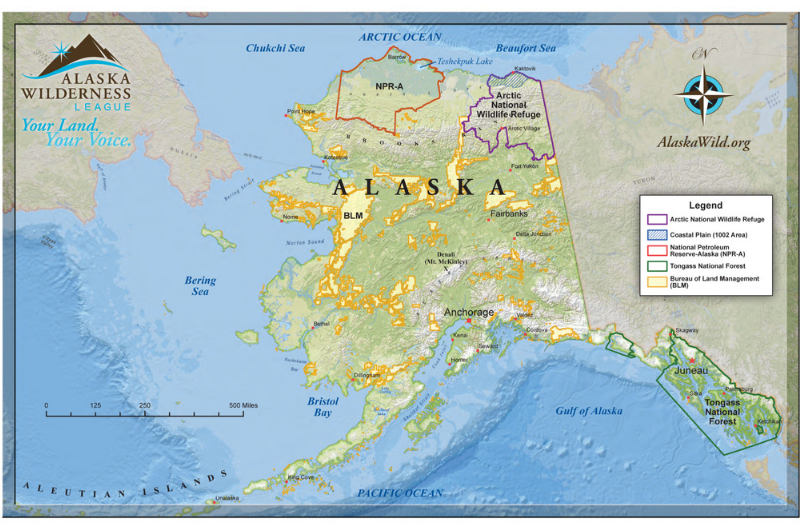 The Arctic Refuge hugs the northeast corner of Alaska. In 2019, the Izaak Walton League passed a strong resolution in support of protecting the coastal plain of the Arctic National Wildlife Refuge and its iconic species of wildlife, including the threatened Beaufort Sea population of denning polar bears, millions of migratory birds and the Porcupine Caribou herd. Proposed oil exploration and drilling would "inevitably lead to the decline of the herd – a devastating threat to the Gwich'in people," the resolution states.
The Arctic Refuge hugs the northeast corner of Alaska. In 2019, the Izaak Walton League passed a strong resolution in support of protecting the coastal plain of the Arctic National Wildlife Refuge and its iconic species of wildlife, including the threatened Beaufort Sea population of denning polar bears, millions of migratory birds and the Porcupine Caribou herd. Proposed oil exploration and drilling would "inevitably lead to the decline of the herd – a devastating threat to the Gwich'in people," the resolution states.
For decades, oil companies eyed the Refuge as a potential drilling bonanza while conservationists championed a hands-off approach. Congress wrestled over drilling legislation many times. On one occasion, the Republican-controlled Senate successfully voted to open the Refuge to development only to be foiled by President Clinton through a line item budget veto. The Obama Administration recommended that nearly all of the Arctic Refuge be designated wilderness.
Then in 2017, the Trump Administration and supportive Alaska politicians inserted a provision in a tax bill that authorized oil lease sales on the coastal plain as a revenue-producing measure. This action caused a tsunami of opposition from the Gwich'in people and conservation groups. Also, several major banks have refused to finance oil development in the Arctic. Legislation that would restore protections to the Arctic Refuge passed the House of Representatives in 2019. And legal challenges to the proposed lease sales were filed on many fronts. Congress and the courts will likely take up these issues in 2021.
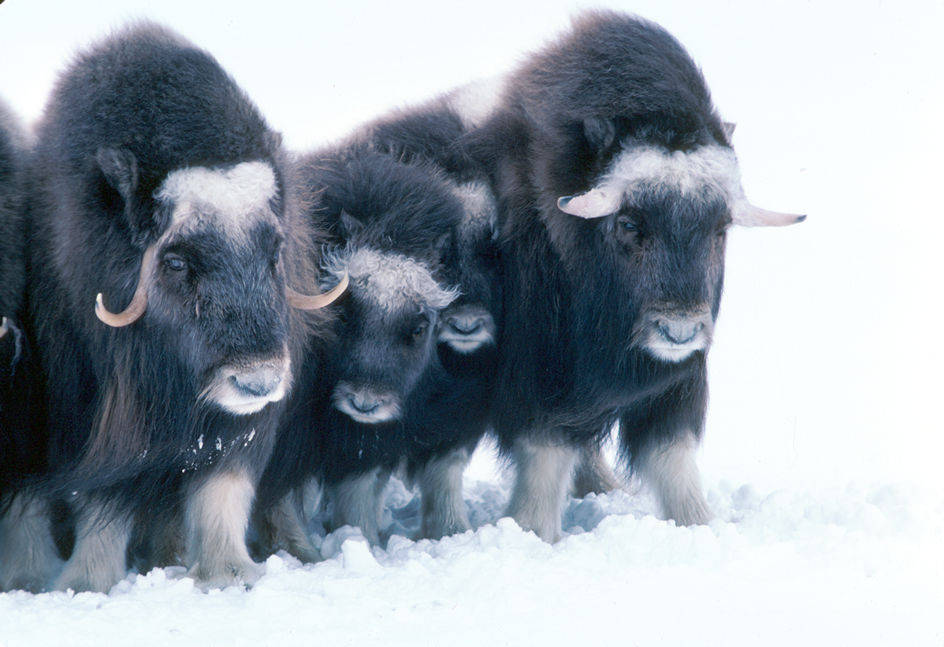
Muskoxen are among the many species that make the Arctic Refuge a rare and unique ecosystem.
The coastal plain is the biological heart of the Refuge. One of the last truly pristine places on earth, this wildlife sanctuary supports an immense diversity and abundance of species, from polar and grizzly bears, to wolves, caribou and muskoxen, to more than 100 bird species that migrate to nest on the tundra and in the wetlands during the endless summer daylight of the Arctic.
Birds such as tundra swans that winter around Chesapeake Bay, or Lapland longspurs that return to grasslands in the Midwest, or the American golden plover that migrates back to Argentina—all begin their lives on the coastal plain of the Arctic Refuge. In fact, every state and six continents have bird species that hatch in the Arctic. We are all connected by the incredible migrations of birds.
For anglers, the Arctic Refuge is home to 42 species of fish, many that thrive in the rivers and ponds of the coastal plain, and in the lagoons: Arctic char, Arctic grayling, Arctic cisco, Dolly Varden trout, flounder and cod. There is no agricultural runoff or industrial pollution to taint these pure waters.
Climate Threat to Arctic Communities
Climate change impacts create great risks for the wildlife and the people of the Arctic. According to a 2019 analysis by the International Arctic Research Center, Alaska is warming faster than any other state and twice as much as the global average since 1950. Glaciers are thinning several feet a year and nearly all are retreating. The depth of annual permafrost thawing has increased by a foot compared to a decade ago. Wildfires are more intense and widespread.
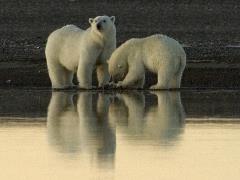 The loss of sea ice has altered polar bear habitat, making the Arctic Refuge more important as a critical denning area for these threatened bears.
The loss of sea ice has altered polar bear habitat, making the Arctic Refuge more important as a critical denning area for these threatened bears.
The warmer sea and air temperatures continue to reduce the thickness and extent of sea ice. Villages see more flooding and coastal erosion, while polar bears are losing sea ice habitat and access to seals, their most important and nutritious food. With unstable ice conditions, the coastal plain of the Arctic Refuge has become more important for denning polar bars and their cubs. During winter, the coastal plain has the highest concentration of land-denning polar bears in America, and they are sensitive to noise and industrial disturbances associated with proposed oil development.
Is it too late to save the polar bears? According to Dr. Steven Amstrup, a senior scientist with Polar Bears International, if the Arctic continues to warm at the current rate, two-thirds of polar bears could disappear within this century. Yet, he is still hopeful if we act now.
“We have the power to stop human-caused climate change and save the arctic ecosystem by greatly reducing greenhouse gas emissions.”
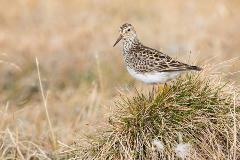 The pectoral sandpiper migrates from South America through the U.S. to the Arctic Refuge every summer.
The pectoral sandpiper migrates from South America through the U.S. to the Arctic Refuge every summer.
The League, along with 97 percent of the world’s scientists, support what Dr. Amstrup has long recognized. In the League’s 2019 resolution to protect the Arctic Refuge, climate change is addressed with certainty:
“… at a time when this country and the world is working to lessen and eliminate the use of fossil fuels to mitigate a climate crisis and move to clean, renewable energy sources to preserve a livable and healthy planet, planning to devastate and destroy one of our last premier wildlife refuges is a major mistake.”
The science is clear. We just need the political willpower and leadership to restore full protections to the Arctic Refuge, to substantially reduce greenhouse gas emissions and to invest in a clean energy future. If we move forward wisely, future generations will have the opportunity to experience a true Arctic wilderness, with polar bears and caribou, and the culture of Alaska's Indigenous people will be honored and protected.
Top photo: The emerald-green Hulahula Valley framed by the Brooks Range provides habitat for moose, wolves, grizzly bears and Dall sheep in Alaska's pristine Arctic Refuge. Credit: Mason Cummings, The Wilderness Society.